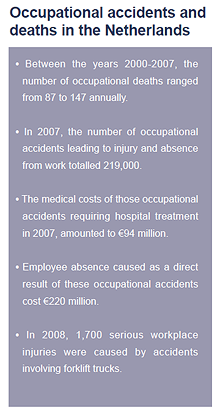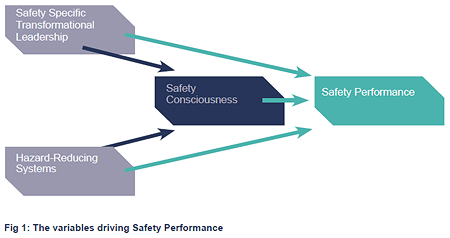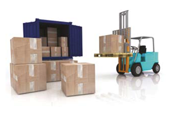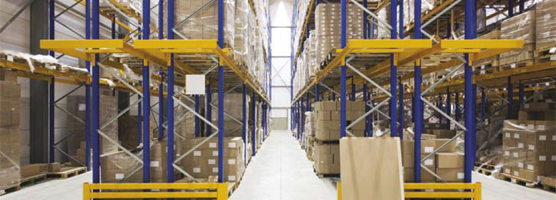Accidents will happen: Do hazard-reducing systems help?
By <link people rene-de-koster _blank>René de Koster, <link people daan-stam _blank>Daan Stam and <link people bert-balk _blank>Bert M. Balk
In the summer of 2009, soon after the winners of the annual Safest Warehouse of the Year Awards were being lauded at an industry conference, journalist Marcel te Lindert wondered out loud in his regular column for the Dutch magazine Logistiek, why it was that there were more questions raised about safety issues than there were answers.
Getting straight to the heart of the matter, he asked how those involved in warehouse management knew which safety measures worked versus those that did not. Surely, he said, it is about time for a serious scientific study into the effectiveness of safety systems.

René de Koster
He was right, no research of substance had been conducted into warehousing accidents and the impact of the systems that are meant to prevent them. And, as the major fire at Chemie-Pack’s warehouse in the small Dutch town of Moerdijk in January shows, accidents can have huge consequences that reach far beyond the confines of the facility in which they happen.
So, with the support of Marcel te Lindert’s publisher and the cooperation of the Dutch organisation of manufacturers and importers of material handling equipment (BMWT), we took up the challenge.
Statistically, the warehousing sector does not have a very good reputation when it comes to occupational safety. If you look at data for workplace accidents in the Netherlands, then the construction sector typically features as the most hazardous. Warehousing, although the Dutch Centraal Bureau voor de Statistiek (CBS) does not identify it as a standalone sector for statistical purposes, comes a close second.
Part of the reason for the high number of occupational accidents in warehouses is that work can be conducted under a lot of pressure. There are delivery times to be met, regardless of the volume of orders. It doesn’t matter if there are 1,000 orders to be fulfilled in one day or 10,000 the next, they still need to be picked, packed and processed in time for the scheduled collections. That’s one side of the story.
The other side of the story is that in many cases the systems used to achieve the time-driven goals involve forklift trucks and heavy moveable machinery weighing up to as much as eight tonnes. Working in the same space are employees on foot and as we know only too well, accidents happen, and sometimes with deadly consequences. The problem here is that it is difficult to create an environment where man and machinery do not mix. After a review of what little scientific literature exists in this area, we identified two existing constructs, that of Safety-Specific Transformational Leadership (SSTL) and Worker Safety Consciousness (WSC). SSTL defines the ways and means by which managers are able to transfer safety issues to the workforce and motivate their safety consciousness. In both constructs, how managers lead in promoting safety can or should have a strong impact. This, at least, was our main hypothesis.
 The first stage of our research was to measure the number of accidents in the Netherlands, which we did from three and a half years’ worth of data, and place them into five already defined accident categories, the three most serious of which have to be reported to the Labour Inspection department of the Ministry of Social Affairs:
The first stage of our research was to measure the number of accidents in the Netherlands, which we did from three and a half years’ worth of data, and place them into five already defined accident categories, the three most serious of which have to be reported to the Labour Inspection department of the Ministry of Social Affairs:
- Near occupational accidents;
- Occupational accidents resulting in injury but not leading to absence;
- Occupational accidents resulting in injury and minimal absence from work of one day;
- Occupational accidents resulting in hospital admission after a visit to the Emergency Department of a hospital;
- Fatal occupational accidents.
Secondly, we looked at the number and type of safety systems used in warehouses. As a sector, warehouses implement numerous safety-enhancing systems that include a diverse range of safety procedures and safety equipment (for example, anti-collision devices, globe mirrors, safety signs and personal protective equipment). So diverse are these that a handbook published by the BMWT advises of a bewildering 300 different safety-enhancing measures that warehouse managers can utilise.
Armed with the information on safety measures and statistical data, a survey was developed with the purpose of (1) defining what we called Hazard-Reducing Systems (HRS) - the systems available to managers in order to enhance warehousing safety (and so for the first time making them measurable), (2) defining safety performance, (3) demonstrating that safety performance is driven by managerial leadership, accident registration and safe storage procedures - factors that are mediated by safety consciousness, and (4) deriving managerial insights by making explicit which measures help to reduce accidents in warehouses.
From the 300 or so different safety-enhancing measures outlined in the BMWT handbook, we condensed them into 70 key HRS and placed them in four groups. The starting point of our survey was to ask participants to what degree the HRS had been implemented.
By analysing the statistical data and the results of the survey, for which we received input from both managers and employees, we were able to look for insights from the following variables: 1) the number and type of accidents, 2) the safety leadership abilities of managers as expressed by employees, 3) the perceived safety consciousness of the workforce, and 4) the hazard-reducing systems currently in place.
How leadership influences safety
In Fig 1, we outline our hypothesis that SSTL positively influences safety performance, an effect that is mediated by safety consciousness. What helps drive this leadership more than anything is the introduction of HRS, something that managers must take responsibility for. One way of looking at it then is that from the perspective of the workforce the manager is the most crucial link in the safety chain. It is the manager who helps to develop and instil the environment of safety consciousness in the workplace that, combined with SSTL and HRS, impacts on overall safety performance.

We grouped HRS into four factors thus: safe traffic systems, hygiene, safety training, and safe storage systems. Safe traffic systems relate to the separation of people and machinery flows. High hygiene standards go hand in hand with high safety standards and this is recognised in the second factor. The third factor identifies the level and frequency of safety training. Standards and procedures for the correct storage of stock - empty pallets, equipment, machinery and tools, for example – fall into our final category.

Daan Stam | Our findings show that of these four factors, safe storage systems have the greatest impact upon the effectiveness of safety leadership. In turn, the safety leadership of managers, partially mediated by the safety consciousness of the workforce, has the greatest impact on the number of accidents in warehousing facilities. Serious and sustained attention to safety brought about by strong safety leadership makes workers more conscious of risks and so reduces accidents. Safety is therefore not a onetime issue, but is something that requires constant managerial attention. Another important driver is the careful registration of near and minor accidents that health and safety legislation does not require employers to record. Our findings indicate that recording these lesser events further fosters a culture of awareness of potential dangers and so provides managers with opportunities for even more hazard reduction, thus exemplifying proactive safety leadership. This is an action we see taken by warehousing facilities with the best safety records. |
In conclusion, we have four variables that impact upon the number of accidents: safety leadership, accident registration, workplace safety consciousness, and safety storage procedures. Linking to these is the manager, the most important factor of all. The effectiveness of managers in safety leadership is strongly influenced by the safety procedures and systems that are in place. With a proactive manager and strong safety leadership even the least modernised and most accident-prone of warehouses can become a safe place to work.
To be an effective safety leader, appropriate safety-related incentives need to be offered to the workforce. If the right incentives are not offered then the workers will be less willing to comply with safety procedures and overall safety consciousness in the warehouse is not improved.
So how can managers encourage employees to become more aware of safety issues through incentives? One way is to incorporate safety into appraisals. We don’t mean once a year personnel appraisals, but instead team performance evaluations specifically aligned to safety conducted at regular intervals, even weekly.

Bert Balk
To do so will increase employee awareness of safety issues, compliance with which should be rewarded, as should increases in safety standards. Rewards should not be monetary and instead should be shown through an appreciation of employee efforts. Aligned to that should be worker empowerment. In this way, management drives to improve safety standards are more than just top down efforts, and instead continuous improvements are instigated and developed by those at the sharp end of safety matters.
Looking at the shortlist of nominations for the 2010 Safest Warehouse of the Year Award, one of the companies, Boston Scientific, has its warehousing staff divided into teams. These teams have been empowered to develop their own Key Performance Indicators (KPI) and this includes the whole area of safety.
The workforce at the spare parts facilities of Nissan in the Netherlands, another high performing warehouse, is also divided into teams. All are empowered to a very large degree and each is responsible for creating and meeting their own KPIs, one of which relates to improvements and innovations in processes leading to lower costs, higher quality, and increased safety. Every month managers present the innovations suggested by their teams and the best ones are implemented right across the board.
 Smart managers are realising the consequences of laxity in safety leadership. Not only does it have a negative impact on the workforce and lead to higher direct and indirect costs, but it can also damage company reputation: reputation as an employer and as a company with which to do business. Those same managers also acknowledge that a proactive attitude to safety leadership and hazard reduction can lead to reduced costs for the organisation, increase employee satisfaction, and improve productivity and quality of work. In addition, such an attitude can help organisations avoid the sort of major catastrophe as experienced by Chemie-Pack. The benefits to businesses are therefore obvious.
Smart managers are realising the consequences of laxity in safety leadership. Not only does it have a negative impact on the workforce and lead to higher direct and indirect costs, but it can also damage company reputation: reputation as an employer and as a company with which to do business. Those same managers also acknowledge that a proactive attitude to safety leadership and hazard reduction can lead to reduced costs for the organisation, increase employee satisfaction, and improve productivity and quality of work. In addition, such an attitude can help organisations avoid the sort of major catastrophe as experienced by Chemie-Pack. The benefits to businesses are therefore obvious.
<link people rene-de-koster _blank>René de Koster is Professor of Logistics and Operations Management, Department of Management of Technology and Innovation, Rotterdam School of Management, Erasmus University. He is also Chairman of the Safest Warehouse of the Year Award and the academic driving force behind the Material Handling Forum.
<link people daan-stam _blank>Daan Stam is Assistant Professor of Innovation Management, Department of Management of Technology and Innovation, Rotterdam School of Management, Erasmus University.
<link people bert-balk _blank>Bert M. Balk is Professor of Economic Measurement and Economic-Statistical Research, Department of Management of Technology and Innovation, Rotterdam School of Management, Erasmus University.
This article was adopted from RSM Insight 5, 1st Quarter 2011.


